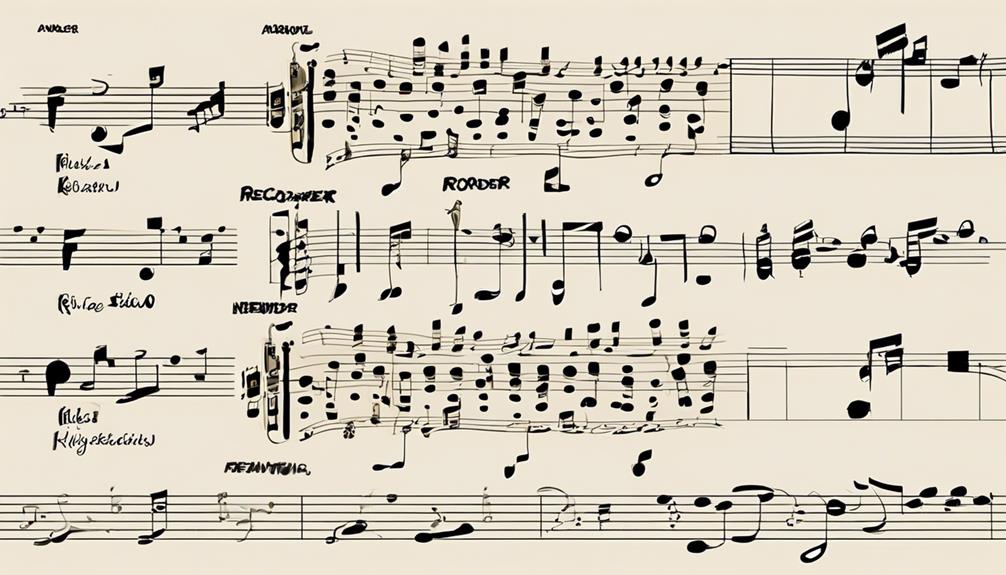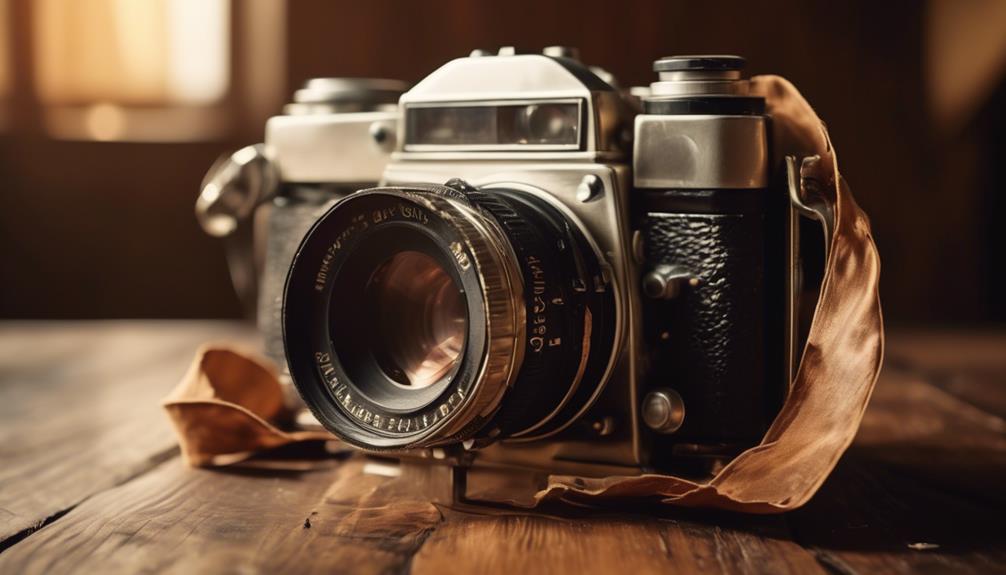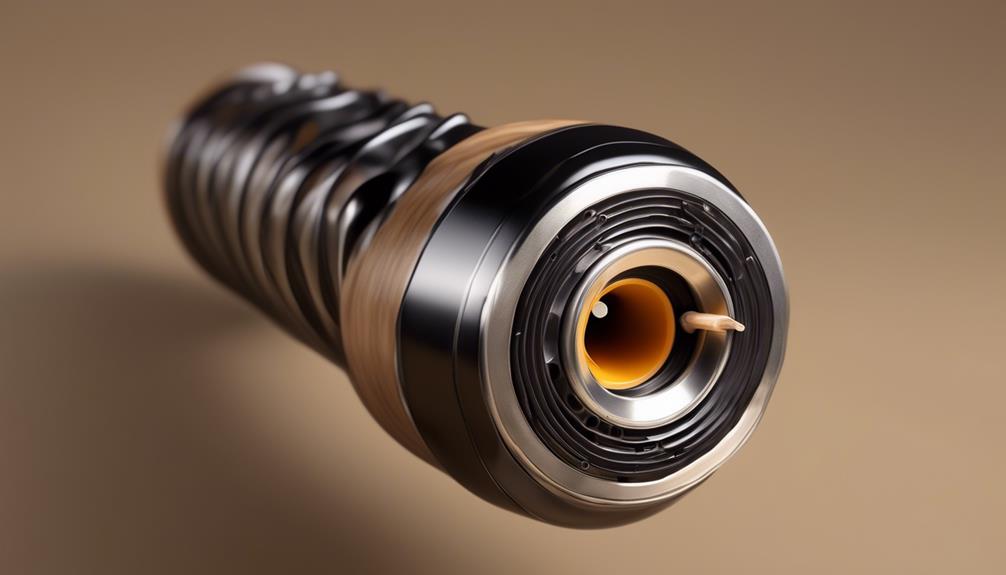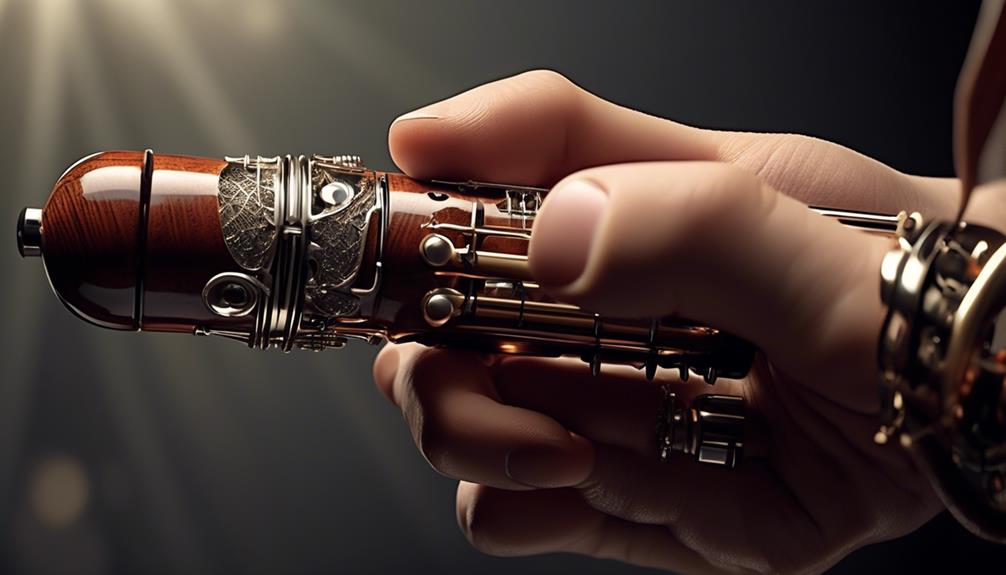When I began learning how to play the recorder, I often felt like a detective searching for a hidden treasure. The pursuit of finding F sharp on a recorder can be quite tricky, similar to finding a rare gem in a vast, mysterious cave.
The journey to uncovering the whereabouts of this elusive note involves a delicate balance of finger placements and breath control. As we navigate the intricacies of recorder fingerings, it's essential to understand the concept of accidentals and how they influence the notes we produce.
However, just when you think you've grasped the technique, there's a surprising twist that makes playing F sharp on the recorder a fascinating challenge. Curious to uncover the secrets of this elusive note?
Stay tuned to discover the keys to mastering the recorder and unleashing the full range of musical possibilities.
Key Takeaways
- Proper finger placement for playing F sharp on the recorder involves covering all the holes except for the bottom pinky and pointer finger.
- Alternative fingerings may be used for F sharp in certain circumstances.
- F sharp and G flat share the same fingering on the recorder.
- Experiment with different fingerings and use a tuner to ensure playing F sharp in tune.
The Basics of Recorder Fingerings
Covering the basics of recorder fingerings, let's explore the essential techniques for playing different notes on the recorder.
When it comes to playing F sharp on the recorder, it's crucial to understand the proper finger placement. To play F sharp in the first octave, the standard fingering involves covering all the holes except for the bottom pinky and pointer finger – the fingering sequence being 0 1 2 3 5 6a 6b. Alternatively, under certain circumstances, an alternative fingering of 0 1 2 3 4 5 6a 6b 7a can be used.
When playing F sharp, start by playing the note D and then lift the first finger of the right hand. Progress to playing from G to F sharp by adding fingers two and three of the right hand.
It's important to note that F sharp and G flat share the same fingering on the recorder, as they're enharmonic equivalents. Additionally, F sharp may have a slightly weaker tone compared to surrounding notes, so it's advisable to avoid blowing too hard. In certain situations, it may need to be played slightly flatter for tuning purposes.
Mastering the fingerings and techniques for playing F sharp on the recorder is essential for achieving a proficient and accurate performance.
Understanding the Concept of Accidentals
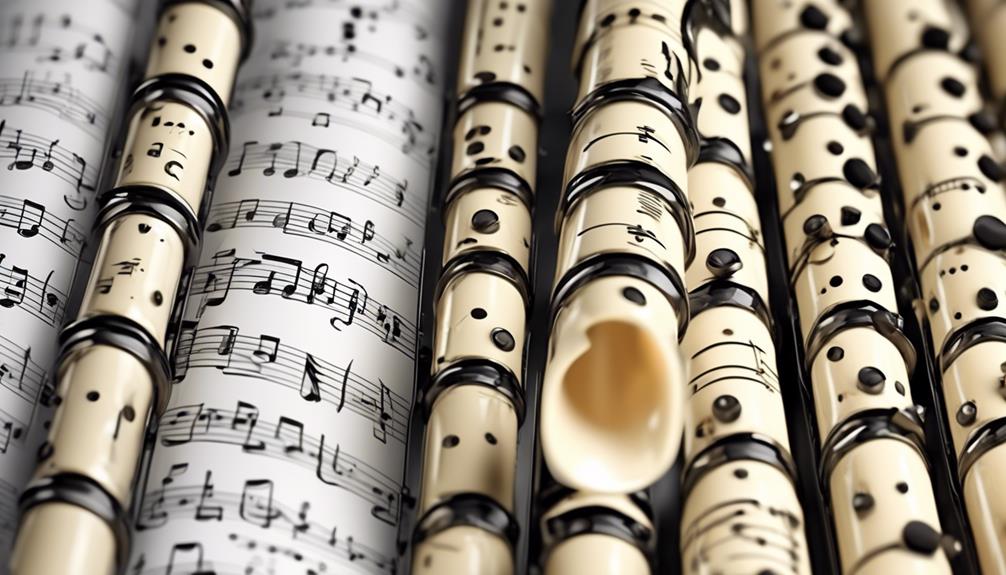
Now that we've explored the essential techniques for playing different notes on the recorder, let's delve into the concept of accidentals and their significance in music theory. Accidentals are vital in altering the pitch of a note, and understanding them is crucial for mastering the recorder. They are temporary and can be found in sheet music, indicating a change in the pitch of a specific note. Below is a table illustrating the accidentals and their corresponding fingerings on the recorder:
| Note | Fingering |
|---|---|
| F♯ | OOO OOO |
| C♯ | OO OOO |
| G♯ | O OOO |
| D♯ | O OO |
The table provides the fingerings for playing F♯, C♯, G♯, and D♯ on the recorder. These notes are crucial in understanding accidentals and their application on the instrument. Additionally, it's important to note that F♯ is the same as G♭, known as the enharmonic equivalent. When reading sheet music in treble clef, F♯ is indicated by the key signature, and it should be played by covering the bottom hole on the recorder's right hand. Mastery of accidentals is essential for accurately interpreting the music's key signature and playing the recorder proficiently.
Exploring the Technique for Playing F Sharp
Exploring the technique for playing F sharp on the recorder involves mastering the finger placement and breath control required for producing this specific note accurately. To achieve mastery in playing F sharp on the recorder, consider the following:
- Experiment with different fingerings: Try various fingerings to find the one that best suits your recorder and personal technique.
- Use a tuner: Ensure that your F sharp is played in tune by using a reliable tuner to guide your intonation.
- Practice breath control: Focusing on breath control is essential to produce a clear and consistent F sharp tone.
- Record and review: Use a recording device to capture your F sharp and identify areas for improvement in your technique.
- Seek guidance: Consult with a recorder teacher or experienced player for personalized feedback and tips on mastering F sharp on the recorder.
When playing F sharp, remember that it's the enharmonic equivalent of G flat.
Additionally, refer to resources such as the Sibelius score, Dolmetsch Online, and other reputable sources for further guidance on playing F sharp across different recorder types, such as the baroque soprano or other octaves.
Teaching F Sharp on the Recorder

To effectively teach F sharp on the recorder, it's important to understand the specific finger placement and breath control required for producing this note accurately.
When teaching F sharp on the recorder, start by explaining the fingering for this low note – cover all the holes except the lower middle finger and the bottom pinky.
Encourage students to practice breath control and tonguing exercises to improve precision. It's also beneficial to explore alternate fingerings and seek advice from experienced players.
Utilize a fingering chart specific to the recorder model and style being used. Additionally, suggest using a mirror to ensure correct finger placement and alignment.
Once students are comfortable playing F sharp, progress to exercises and pieces that incorporate this note. Consider using a Sibelius score to provide musical contexts for practicing F sharp.
Remember that F sharp is the enharmonic equivalent of G flat, so connecting this knowledge can deepen understanding.
Incorporating F Sharp Into Recorder Songs
As we incorporate F sharp into recorder songs, it's essential to build on the foundational understanding of finger placement and breath control that was emphasized in teaching this note. When playing F sharp on the recorder, mastering the fingering is crucial. In addition, maintaining proper breath control is essential for producing a clear and steady sound.
To further enhance our understanding, we should consider the following:
- Understanding F Sharp: Recognizing F sharp as a sharp note, slightly higher in pitch than F, expands the repertoire of notes on the recorder.
- Transitioning Smoothly: Ensuring smooth transitions between F sharp and other notes in the first octave is vital for playing melodious tunes.
- Exploring Enharmonic Equivalents: Exploring the enharmonic equivalent of F sharp, G flat, in Sibelius scores can provide a deeper understanding of its usage in different musical contexts.
- Practicing Exercise Pieces: Engaging in exercise pieces specifically designed to incorporate F sharp can help in mastering this note effectively.
- Seeking Expert Advice: Seeking guidance from experienced musicians or instructors for personalized advice and tips on playing F sharp can be invaluable.
Frequently Asked Questions
What Note Is F on the Recorder?
F sharp on the recorder is a sharp note, slightly higher in pitch than F. To play it, cover the first two holes with the left hand and leave the rest uncovered.
Alternative fingering is 0 1 2 3 4 5 6a 6b 7a.
For better sound quality, avoid blowing too hard and experiment with hand and finger techniques. Tuning exercises and ear training can help improve intonation.
Varying breath control and articulation techniques can enhance expressive playing.
What Is a Sharp on Recorder?
A sharp on a recorder refers to a note that's slightly higher in pitch than its natural counterpart. In terms of recorder fingering, playing sharp notes often involves covering specific combinations of holes on the instrument. These sharp notes are essential for playing in different musical scales and are indicated by a sharp symbol in recorder music.
Adjusting the pitch and employing proper recorder techniques are crucial for accurately playing sharp notes in various key signatures.
What Is the Difference Between F and F Sharp?
The difference between F and F sharp lies in their pitch. In music theory, F sharp is a half step higher than F, representing an increase in the interval distance.
Both F and F sharp are enharmonic notes, meaning they have the same fingering on the recorder.
In the context of a key signature or a chromatic scale, F sharp would be notated with an accidental, raising the pitch by a semitone.
How Do You Play E and F on the Recorder?
To play E and F on the recorder, finger positions are crucial for pitch accuracy. We coordinate fingers for smooth note transitions and work on breath control for musical expression.
We improve articulation skills and playing dynamics through practice techniques. Recorder technique involves covering holes precisely, and we focus on producing a clear tone.
With dedicated practice, we master the nuances of playing E and F on the recorder.
Can Microsoft Teams Calls Be Intercepted Using F Sharp on the Recorder?
Yes, boss monitoring Microsoft Teams calls can be intercepted using F Sharp on the recorder. It provides a means for employers to track and record employees’ conversations on the platform. This raises concerns about privacy and the potential misuse of such monitoring capabilities.
Conclusion
So there you have it folks, F sharp on the recorder is like finding a hidden treasure! Just cover all the holes except for the bottom pinky and pointer holes, and voila! You've unlocked the secret to playing F sharp.
It's like a secret code that only recorder players understand. Keep practicing and soon you'll be playing F sharp like a pro!
Happy recorder playing!

